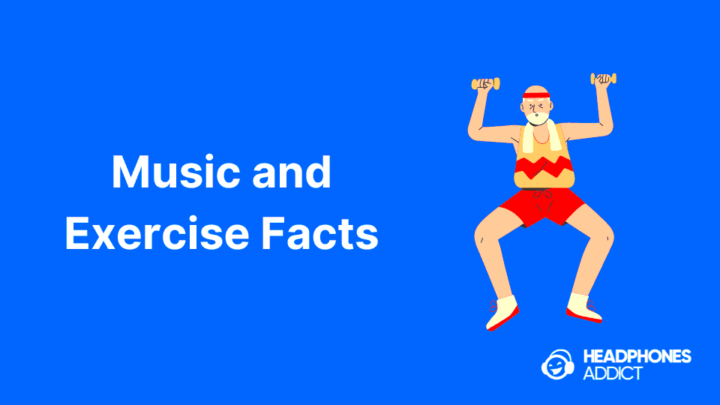Here are research-backed benefits and drawbacks of using headphones for work.
What do studies say about wearing headphones in the office?
See how many workers use headphones when working and how many think it improves productivity.

Is It Good to Use Headphones for Work?
Whether or not using headphones for work is a good idea depends on the nature of your work, where you work (your work environment), and personal choice.
KEY TAKEAWAY:
- Using headphones for work has benefits and drawbacks. It mostly depends on the type of work, work environment, and individual preference.
- The benefits of wearing headphones for work are a sense of privacy, the removal of background noise and distractions, and an increase in focus.
- Studies show that most workers find listening to music during work improves productivity.
- Qualities to look for in headphones for work: high comfort for long work hours, passive and active noise cancellation, and a quality microphone for clear calls.
There are a couple of benefits of using headphones for work:
Removing noise in the workplace

Headphones help you block out distracting noise, so you can focus on the task at hand.
Closed-back headphones and in-ear earphones provide good passive noise isolation by just putting them on.
Headphones with active noise cancellation (ANC) additionally remove unwanted background noise with the help of technology.
Passive noise isolation vs. ANC
Privacy
One of the main reasons people wear headphones is to communicate they want to be left alone. When you put on headphones, your coworkers and people around you will generally leave you alone.
That way, you can have a sense of privacy even in an open office with many people.
Concentration
Listening to music, especially classic rock, helps you concentrate and get your mind into work mode.
Music has many benefits and improving focus and creativity is one of them. Using it to your advantage is easy with headphones.
55.4% of people regularly use headphones at work – CloudCover survey
Should You Listen to Music While Working?
Most people find listening to music with headphones improves productivity, according to research sources below.
What’s the research?
A Robert Half survey found that 71% of workers say they’re more productive when listening to music. 39% of them claim they’re much more productive.
Another study, CloudCover survey, found almost 80% of workers think music increases their productivity.
| What workers say about listening to music | Percentage |
|---|---|
| It increases productivity | 78.4% |
| It makes no difference | 17.4% |
| It lowers productivity | 4.2% |
And the majority of workers also say using headphones when working improves productivity.
| What workers say about using headphones for work | Percentage |
|---|---|
| It increases productivity | 66.1% |
| It makes no difference | 24.6% |
| It lowers productivity | 9.4% |
They’ve asked the workers to rate which music genres improve productivity and which decrease it.
Here are the 5 most productive and most distracting music genres:
| Most productive | Music genre | Most distracting | Music genre |
|---|---|---|---|
| 31% | Classic Rock | 37.7% | Hip Hop |
| 27.4% | Alternative | 37.1% | Heavy Metal |
| 26.1% | Pop | 27.7% | EDM |
| 21.3% | Classical | 23.3% | Country |
| 21.1% | Hip Hop | 17.6% | Holiday songs |
What’s interesting is how workers rated Hip Hop. Almost 40% of workers find listening to Hip Hop during work distracting, while 1 in 5 find it improving their productivity.
So, it’s the #1 most distracting music genre for most people, while the #5 most productive at the same time.
How many companies have a headphones policy?
Over 80% of companies allow wearing headphones during work without or with some restrictions.
Here are the answers from the report:
| Percentage | Company headphone policy |
|---|---|
| 44% | Allowed without restrictions |
| 38% | Allowed with restrictions |
| 9% | Not allowed |
| 10% | I don’t know |
What are the main reasons people use headphones in the workplace?
- 46% of workers use headphones to avoid conversation at work.
- 30% of workers use headphones to cancel background noise and distractions.
There are plenty of good reasons to use headphones. But it depends on your personal preference and work environment.

If you work in a noisy, distracting workplace, headphones help you to be left alone, so you can focus on work.
What are the Best Headphones for Work?
The best headphones for work should do a couple of things well:
- Give you privacy by removing noise
- Sound good for music and chatting
- Offer a comfortable fit for hours
- Have a quality microphone (if needed)
To get the above benefits, look for these features in headphones:
Active noise cancelling
Noise-cancelling headphones are perfect for reducing background noise, so you can focus on work without distractions.
Active noise cancellation (ANC) is especially effective against constant noise like city noise, traffic, and white noise. They work in any noisy work environments.
The only bad thing is that ANC headphones are generally more expensive than regular ones.
Passive noise isolation
Passive noise isolation is equally important as ANC. If you’re looking to block as much noise as possible. In that case, good passive noise isolation is very useful in work headphones.
The difference is that ANC requires power while isolation works passively by using sound-absorbing materials and design to block ambient noise.
Bluetooth
Bluetooth headphones connect to devices wirelessly, eliminating cables. They provide a hassle-free experience. Seamlessly connect to multiple devices. And avoid problems with entangled cords.
With Bluetooth, you can connect to your smartphone, laptop, tablet, TV, or any other Bluetooth-enabled device.
Wireless headphones are more convenient, with only one drawback. You have to charge them.
A quality microphone (if needed)
A clear microphone for business phone calls or video chats is crucial.

It’s hard to do business with people who have a bad mic. And you don’t want to be one.
Higher-end headphones and earbuds usually have better microphone quality. We test the clarity of the microphones of each pair of headphones (you can find them in our headphone reviews).
So you know exactly what to expect and how a specific pair of headphones sounds for phone calls.
Also check:
Hear-through mode (ambient sound mode)
A hear-through mode (also known as awareness mode, ambient sound mode, and Transparency mode in AirPods) is useful for talking with people around you.
With a press of a button, you can talk with coworkers without taking your headphones off. It’s handy for working in groups when you’re expected to communicate while keeping a sense of privacy.
Transparency mode uses microphones that pick up the conversation of people around you and send it to your headphones. At the same time, many headphones automatically lower the headphone audio volume, so you can hear clearly.
What are the best types of headphones for working?
The best types of headphones for working:
Earbuds
Earbuds (also known as in-ear headphones) are small, lightweight, and easier to pack and hide. They’re a great portable option for on-the-go work and travel.

If you have to travel from location to location for your work, earbuds are more convenient to carry around.
Generally, earbuds are also more affordable than other headphone types and come with a carrying case that protects and charges them.
Their passive noise isolation is also best-in-category. And if you find a quality pair of ANC earbuds, they won’t let you get distracted no matter where you work.
Over-ear headphones
Over-ear headphones are bigger and heavier but more comfortable than earbuds for extended periods of time.
Plus, they’re more visible. So, when you wear over-ear headphones, you obviously want to be left alone and focus on work.
The only bad thing is that they’re less convenient to carry around. The carrying cases of over-ears can be pretty big and don’t fit into a pocket.
What are the Risks Associated With Using Headphones for Work?
Wearing headphones during work has many benefits but also some risks.
Here are the main concerns:
- Wearing headphones makes it difficult to communicate with coworkers:
When you’re wearing headphones, coworkers are less likely to approach you with questions and concerns regarding work. Because headphones are a sign you want to be left alone, sometimes it can have a detrimental effect.
To fix it: Get headphones with hear-through (ambient sound, transparency mode) for easier communication.
- Some companies or bosses don’t allow using headphones during work:
In some companies, it’s against the policy to wear headphones. In many workplaces, the rules exist for good reasons, and in some, it’s just the managers’ preference.
To fix it: You can ask your manager and explain the benefits of using headphones during work to change the rules.
- Listening to headphones for a long time can cause hearing damage (at unhealthy volumes):
Listening to headphones at higher volumes for an extended time can lead to noise-induced hearing loss. This is especially common in noisier work environments, where people are likely to increase the volume to compensate for ambient noise.
To fix it:
- A pair of quality headphones with effective noise isolation and ANC can largely fix the problem.
- Take regular breaks.
- Ear infections from earphones:
Wearing earbuds (in-ear headphones) for hours daily can lead to ear infections. Especially if the earbuds aren’t clean.
But that requires explanation…
The commonly held belief is that wearing earbuds (in-ear headphones) can cause an ear infection. But a study of 118 customer services representatives who used earphones 8 hours per day for work found no significant correlation. They found only 4 cases of chronic middle ear infection.
In other words, the chance of catching an ear infection from wearing earphones is not much higher than otherwise.
On the other hand, doctors agree that accumulating bacteria on earphones can increase the risk of infections. But this is more of a risk when you share earphones with others. The introduction of new bacteria into your organism increases the chance.
So, keep your earbuds to yourself to lower the risk.
To fix it: Regularly clean them. Learn how to clean earbuds and headphones.
Tips for Using Headphones During Work
Here’s how to use headphones while working to improve focus and productivity:
Fit the headphones for maximum comfort
Take time to adjust the headband for optimal comfort. Try all the ear tips that come with the earbuds. Potentially replace the original ear pads and ear tips with better ones that offer longer comfort.
Headphones that are too tight can cause discomfort or headaches after a couple of hours. If they’re too loose, they often let in more background noise.
Use a safe volume level
We’ve said many times that headphones can produce dangerous levels of volume, leading to hearing loss over time.
For safety reasons, keep it under 85 dB volume level, as recommended by experts (read more about it in our safe volume article)
Take the headphones off every couple of hours
Taking regular breaks helps prevent hearing damage and discomfort. Give your ears a bit of time to relax.
Preferably take off your headphones every hour or so.
Stay aware of your coworkers

If coworkers want to communicate with you, they’ll probably give you some non-verbal signs. Stay aware of eye contact that signals the desire to talk more. You don’t want to miss anything important.
Know when to remove the headphones
Sometimes it’s more appropriate to take off your headphones. During a meeting or a collaborative project, it’s almost necessary to do so.
If you follow the tips above, you can effectively use headphones during work, enjoy the benefits and avoid the risks.
FAQs
Should I use headphones for work?
Listening to headphones improves productivity, gives you a sense of privacy, and removes distractions, so you can focus on work.
Are there any risks associated with using headphones for work/focus for long periods of time?
The risk associated with using headphones for work and focus are: the potential for noise-induced hearing loss if listening for a long time and at higher volumes, difficulties communicating with coworkers, breaking company policy, and potential ear infections from unclean earphones.
How many workers use headphones in the US?
The majority of workers, over 55%, use headphones when working in some capacity.
What are the main reasons people use headphones at work?
46% of people use headphones at work to avoid conversation. 30% use them to remove background noise and distractions.
Conclusion
In conclusion, wearing headphones during work has many benefits. It helps concentration and productivity by removing background noise. Enables you to communicate via phone calls and video chats. And gives you a sense of privacy.
As long as you avoid the drawbacks by taking regular breaks, getting comfortable headphones, and listening at a reasonable volume.

Matija Ferjan is a seasoned audio enthusiast reviewing headphones since 2015. He has personally tested hundreds of headphones and earbuds. He’s an active member of the Headphone Audio community and a true nitpicker, always looking for the “best-value-for-money” headphones.



